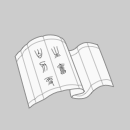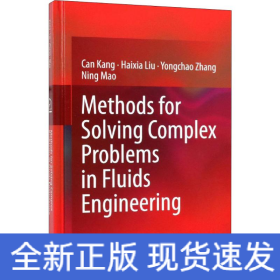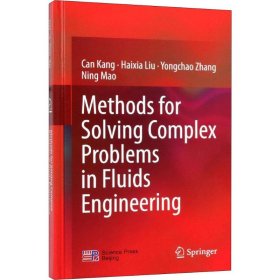
流体工程中复杂问题的研究方法
全新正版 极速发货
¥ 103.94 6.5折 ¥ 159 全新
库存3件
广东广州
认证卖家担保交易快速发货售后保障
作者康灿 等
出版社科学出版社
ISBN9787030587503
出版时间2019-03
装帧平装
开本16开
定价159元
货号1201853962
上书时间2024-08-05
- 最新上架
商品详情
- 品相描述:全新
- 商品描述
-
目录
1 Introduction to Complex Problems in Fluids Engineering
1.1 Background Knowledge
1.2 Strategies for Treating Complex Flows
1.2.1 Fundamental Flow Features
1.2.2 Common Methods for Treating Flow Issues
1.3 Characteristics of Flow Problems
1.3.1 Flow Quantities
1.3.2 Unsteadiness
1.3.3 Symmetry
1.3.4 Stability
1.3.5 Symmetry,Intermittency and Periodicity
1.3.6 Phase Change
1.3.7 Flows in an Integrated System
References
2 A Brief Overview of Research Methods
2.1 Introduction of Experiment
2.1.1 Definition of Experiment
2.1.2 Experimental Instruments
2.1.3 Fidelity of Experiment
2.2 Numerical Methods for Flows
2.2.1 Governing Equations
2.2.2 Turbulence Model
2.2.3 Turbulent Characteristics
2.2.4 Cavitation Model
2.2.5 Other Issues
2.3 Some Limitations of CFD
2.4 Structural Analysis
References
3 Submerged Waterjet
3.1 Fundamental Features of Submerged Waterjet
3.1.1 Experimental Set-Up
3.1.2 Average Flow Characteristics of Submerged Waterjet
3.1.3 Vorticity Distribution and Pressure Fluctuation
3.1.4 Cavitation
3.2 Submerged Waterjet Issued at Ultra-High Jet Pressures
3.2.1 Cavitation Erosion Mechanism
3.2.2 Experimental Methods and Rig
3.2.3 Results and Analysis
3.2.4 Summary
3.3 Cavitation Simulation for Submerged Waterjet and Experimental Validation
3.3.1 Numerical Model and Procedure
3.3.2 Discussion of Numerical Results
3.3.3 Cavitation Prediction
3.3.4 Experimental Setup
3.3.5 Experimental Results
3.4 Concluding Remarks
References
4 Motion of Bubble
4.1 Rising Bubble in Stationar} Water
4.1.1 Experimental Set-Up and Image-Processing Code
4.1.2 Experimental Results and Analysis
4.1.3 Summary
4.2 Bubbles Released in Horizontal Water Flow
4.2.1 Experimental Preparations
4.2.2 Results and Discussion
4.2.3 Bubble Deformation and Dimensionless Numbers
4.2.4 Summary
References
5 Wake Flow of the Ventilation Cylinder
5.1 Experimental Setup
5.1.1 Water Tunnel and Ventilated Cylinder
5.1.2 Optical Configuration
5.1.3 Bubbles Separation Algorithm
5.2 Velocity and Vorticity Distributions
5.3 Bubbles Size Prediction
5.3.1 Bubbly Flow Patterns
5.3.2 Bubble Size
5.3.3 Comparison of Bubble Size Distribution
5.4 Bubble Velocity Distribution
5.5 Statistical Features of Bubble Volume
5.6 Concluding Remarks
References
6 Drag-Type Hydraulic Rotor
6.1 Introduction
6.2 Experimental Setup
6.2.1 Drag-Type Hydraulic Rotor
6.2.2 Test Segment of the Water Tunnel
6.2.3 PIV Set-Up
6.3 Flow Patterns Near the Hydraulic Rotor
6.3.1 Wake Flow Patterns
6.3.2 Flow Characteristics Near the Rotor
6.3.3 Vorticity Distribution
6.4 Numerical Preparations
6.4.1 Governing Equations and Turbulence Model
6.4.2 Grid Deployment Scheme
6.4.3 Boundary Conditions
6.5 Validation of Numerical Simulation
6.6 Variation of Torque Coefficient with Rotor Rotation
References
7 Viscous Flows in the Impeller Pump
7.1 Introduction
7.2 Pump Structure and Parameters
7.3 Numerical Preparations
7.3.1 Governing Equations and Turbulence Model
7.3.2 Boundary Conditions
7.3.3 Verification of Numerical Settings
7.4 Results and Discussion
7.4.1 Pump Performance
7.4.2 Flow Patterns
7.4.3 Pressure Fluctuations
7.5 Hydraulic Forces Exerted on Impeller Blades
7.6 Concluding Remarks
References
8 Cavitation in the Condensate Pump
8.1 Introduction
8.2 Cavitation Feature of the Centrifugal Pump
8.3 Modification of Impeller Geometry
8.4 Pump Performance Experiment
8.5 Numerical Preparations
8.5.1 Governing Equations,Turbulence Model and Cavitation Model
8.5.2 Grid Deployment Scheme
8.5.3 Boundary Conditions
8.5.4 Validation of the Computational Scheme
8.6 Numerical Results and Discussion
8.6.1 Geometric Features of Cavitation
8.6.2 Effect of Flow Rate on Cavitation at NPSHa=3.0 m
8.6.3 Effect of NPSHa on Cavitation at Design Flow Rate
8.7 Conclusions
References
9 Structural Aspect of the Impeller Pump
9.1 Flow-Structure Interaction in the Molten Salt Pump
9.1.1 A Brief Introduction of the Molten-Salt Pump
9.1.2 Numerical Set-Up for Flow Simulation
9.1.3 Flow Characteristics of the Pump
9.1.4 Numerical Setup for Structural Calculation
9.1.5 Temperature Distribution in the Rotor
9.1.6 Strength Analysis of the Rotor
9.1.7 Modal Analysis
9.1.8 Summary
9.2 Structural Improvement of a Condensate Pump
9.2.1 Overview of the Condensate Pump
9.2.2 Condensate Pump and Vibration Description
9.2.3 Flow Simulation for the Pump
9.2.4 Motor Test
9.2.5 Modal Analysis of the Original Pump Base
9.2.6 Improvement of Motor Supporting
References
内容摘要
康灿、刘海霞、张永超、毛宁编的《流体工程中复杂问题的研究方法(英文版)(精)》描述了很近发展起来的研究方法,用来研究复杂流体工程中存在的问题,特别是光学流量测量,流量可视化和数值方法。它包含了大量的图表和图片。收录了《 Introduction to Complex Problems in Fluids Engineering》《A Brief Overview of Research Methods》《Submerged Waterjet》《Motion of Bubble》等。
相关推荐
— 没有更多了 —




















以下为对购买帮助不大的评价